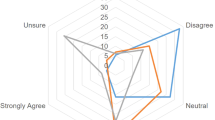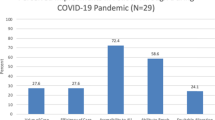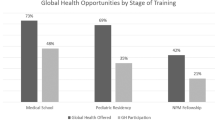Abstract
Objectives
Evaluate the outreach program of a regional NICU for referral satisfaction, drivers and barriers, preferences for service methods, outreach communication, and education.
Study design
To point out prevalence assessment of preferences, referral reasons, satisfaction and general feedback by regional neonatologists implemented by electronic survey using either multiple-choice or Likert scale questions. Survey questions were derived via consensus of the outreach program team.
Results
A 100% response rate was achieved from 136 neonatologists. Over 90% of the respondents indicated either increased or unchanged referral rates and answered “maybe” or “definitely satisfied” with the outreach program. Insurance, bed availability, excellence in subspecialty support, and communication from neonatologists were important referral factors. Research reputation was not a significant driver. Case conferences at referral hospitals and program newsletters were the preferred education methods.
Conclusions
Advanced subspecialty services, communication with referring neonatologists, and access to the referral system are important drivers of satisfaction for referrals to our quaternary NICU.
This is a preview of subscription content, access via your institution
Access options
Subscribe to this journal
Receive 12 print issues and online access
$259.00 per year
only $21.58 per issue
Buy this article
- Purchase on Springer Link
- Instant access to full article PDF
Prices may be subject to local taxes which are calculated during checkout





Similar content being viewed by others

References
Williams TF, White KL, Andrews LP, Diamond E, Greenberg BG. Patient referral to a university clinic: Patterns in a rural state. Am J Public Health Nations Health. 1960;50:1493–507.
Williams TF, White KL, Fleming WL, Greenberg BG. The referral process in medical care and the university clinic’s role. J Med Educ. 1961;36:899–907.
Morrell DC, Gage HG, Robinson NA. Referral to hospital by general practitioners. J R Coll Gen Pract 2972. 1971;21:77–85.
Cummins RO, Smith RW, Inui TS. Communication failure in primary care: failure of consultants to provide follow-up information. JAMA 1980. 1980;243:1650–2.
Hansen JP, Brown SE, Sullivan RJ Jr, Muhlbaler JH. Factors related to an effective referral and consultation process. J Fam Pract 1982. 1982;15:651–6.
Ludke RL. An examination of the factors that influence patient referral decisions. Med Care. 1982;10:782–96.
McPhee SJ, Lo B, Saika GY, Meltzer R. How good is communication between primary care physicians and subspecialty consultants? Arch Intern Med. 1984;144:1265–8.
Byrd JC, Moskowitz MA. Outpatient consultation: interaction between the general internist and specialist. J Gen Intern Med. 1987;2:93–98.
Epstein RM. Communication between primary care physicians and consultants. Arch Fam Med. 1995;4:403–9.
Little DN, Hammond C, Kollisch D, Sten B, Gagne R, Dietrich AJ. Referrals for depression by primary care physicians: a pilot study. J Fam Pract. 1998;47:375–7.
Williams PT, Peet G. Differences in the value of clinical information: referring physicians versus consulting specialists. J Am Board Fam Pract. 1994;7:292–302.
Forrest CB, Glade GB, Baker AE, Bocian AB, Kang M, Starfield B. The pediatric primary-specialty care interface: how pediatricians refer children and adolescents to specialty care. Arch Pediatr Adolesc Med. 1999;153:705–14.
Forrest CB, Glade GB, Starfield B, Baker AE, Kang M, Reid R. Gatekeeping and referral of children and adolescents to specialty care. Pediatrics. 1999;104:28–34.
Binder S, Hill K, Meinzen-Derr J, Greenberg JM, Narendran V. Increasing VLBW deliveries at subspecialty perinatal centers via perinatal outreach. Pediatrics. 2011;127:487–93.
Wasserman RC, Slora EJ, Bocian AB, Fleming GV, Baker AE, Pedlow SE, et al. Pediatric research in office settings (PROS): a national practice-based research network to improve children’s health. Pediatrics. 1998;102:1350–7.
Stille CJ, Primack WA, Savageau JA. Generalist-subspecialist communication for children with chronic conditions: a regional physician survey. Pediatrics. 2003;112:1314–20.
Forrest CB, Glade GB, Baker AE, Bocian A, von Schrader S, Starfield B. Coordination of specialty referrals and physician satisfaction with referral care. Arch Pediatr Adolesc Med. 2000;154:499–506.
Berry JG, Hall M, Hall DE, Kuo DZ, Cohen E, Agrawal R, et al. Inpatient growth and resource use in 28 children’s hospitals: a longitudinal, multi-institutional study. JAMA Pediatr. 2013;167:170–7.
Acknowledgements
The authors thank Scott Lorch, MD, MSCE, for reviewing the survey tool.
Author contributions
John Chuo: participated in survey design, data analysis, manuscript writing and editing. Janet Lioy: study conception, survey design, survey administration, data collection, data analysis and interpretation, and manuscript preparation. Jeffrey Gerdes: participated in survey design, data analysis, manuscript writing and editing.
Funding
This study was funded by the Division of Neonatology, Department of Pediatrics of The Children’s Hospital of Philadelphia.
Author information
Authors and Affiliations
Corresponding author
Ethics declarations
Conflict of interest
The authors declare that they have no conflict of interest.
Publisher's note:
Springer Nature remains neutral with regard to jurisdictional claims in published maps and institutional affiliations.
Rights and permissions
About this article
Cite this article
Chuo, J., Lioy, J. & Gerdes, J. Drivers of referrals to a children’s hospital neonatal–infant intensive care unit. J Perinatol 39, 295–299 (2019). https://doi.org/10.1038/s41372-018-0297-2
Received:
Revised:
Accepted:
Published:
Issue Date:
DOI: https://doi.org/10.1038/s41372-018-0297-2


